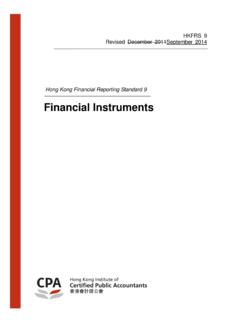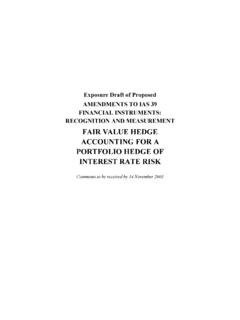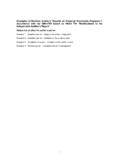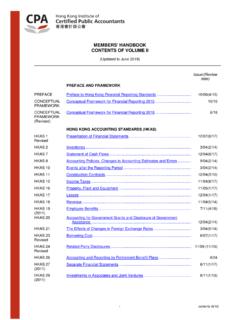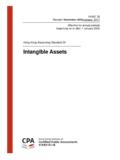Transcription of Hong Kong Accounting Standard 36 - Hong Kong Institute of ...
1 Impairment of Assets Hong Kong Accounting Standard 36 HKAS 36 Revised September 2018 January 2017 HKAS 36 Copyright 2 COPYRIGHT Copyright 2018 Hong Kong Institute of Certified Public Accountants This Hong Kong Financial Reporting Standard contains IFRS Foundation copyright material. Reproduction within Hong Kong in unaltered form (retaining this notice) is permitted for personal and non-commercial use subject to the inclusion of an acknowledgment of the source. Requests and inquiries concerning reproduction and rights for commercial purposes within Hong Kong should be addressed to the Director, Finance and Operation, Hong Kong Institute of Certified Public Accountants, 37/F., Wu Chung House, 213 Queen's Road East, Wanchai, Hong Kong. All rights in this material outside of Hong Kong are reserved by IFRS Foundation.
2 Reproduction of Hong Kong Financial Reporting standards outside of Hong Kong in unaltered form (retaining this notice) is permitted for personal and non-commercial use only. Further information and requests for authorisation to reproduce for commercial purposes outside Hong Kong should be addressed to the IFRS Foundation at Further details of the copyright notice form IFRS Foundation is available at HKAS 36 (March 2010 June 2014) Copyright 3 CONTENTS from paragraph INTRODUCTION IN1 HONG KONG Accounting Standard 36 IMPAIRMENT OF ASSETS OBJECTIVE 1 SCOPE 2 DEFINITIONS 6 IDENTIFYING AN asset THAT MAY BE IMPAIRED 7 MEASURING RECOVERABLE AMOUNT 18 Measuring the recoverable amount of an intangible asset with an indefinite useful life 24 Fair value less costs to disposal 28 Value in use 30 Basis for estimates of future cash flows 33 Composition of estimates of future cash flows 39 Foreign currency future cash flows 54 Discount rate 55 RECOGNISING AND MEASURING AN IMPAIRMENT LOSS 58 CASH-GENERATING UNITS AND GOODWILL 65 Identifying the cash-generating unit to which an asset belongs 66 Recoverable amount and carrying amount of a cash-generating unit 74 Goodwill 80 Allocating goodwill to cash-generating units 80
3 Testing cash-generating units with goodwill for impairment 88 Timing of impairment tests 96 Corporate assets 100 Impairment loss for a cash-generating unit 104 REVERSING AN IMPAIRMENT LOSS 109 Reversing an impairment loss for an individual asset 117 Reversing an impairment loss for a cash-generating unit 122 HKAS 36 (June November 2014) Copyright 4 Reversing an impairment loss for goodwill 124 DISCLOSURE 126 Estimates used to measure recoverable amounts of cash-generating units containing goodwill or intangible assets with indefinite useful lives 134 TRANSITIONAL PROVISIONS AND EFFECTIVE DATE 139 WITHDRAWAL OF SSAP 31 141 APPENDICES A Using present value techniques to measure value in use B Amendment to HKAS 16 C Impairment testing cash-generating units with goodwill and non-controlling interests D Comparison with International Accounting standards BASIS FOR CONCLUSIONS DISSENTING OPINIONS ILLUSTRATIVE EXAMPLES TABLE OF CONCORDANCE Hong Kong Accounting Standard 36 Impairment of Assets (HKAS 36) is set out in paragraphs 1-141 and Appendices A - DC.
4 All the paragraphs have equal authority. HKAS 36 should be read in the context of its objective and the Basis for Conclusions, the Preface to Hong Kong Financial Reporting standards and the Conceptual Framework for Financial Reporting. HKAS 8 Accounting Policies, Changes in Accounting Estimates and Errors provides a basis for selecting and applying Accounting policies in the absence of explicit guidance. HKAS 36 (March 2010 June 2014) Copyright 5 Introduction IN1 Hong Kong Accounting Standard 36 Impairment of Assets (HKAS 36) replaces SSAP 31 Impairment of Assets (issued in 2001), and should be applied: (a) on acquisition to goodwill and intangible assets acquired in business combinations for which the agreement date is on or after 1 January 2005. (b) to all other assets, for annual periods beginning on or after 1 January 2005.
5 Earlier application is encouraged. Reasons for issuing HKAS 36 IN2 Pursuant with its convergence policy, the Hong Kong Institute of Certified Public Accountants ( HKICPA ) issues HKAS 36 as part of its project on business combinations to converge with the International Accounting Standard Board ( the Board ) s project on business combinations. The project s objective was to improve the quality of the Accounting for business combinations and the subsequent Accounting for goodwill and intangible assets acquired in business combinations. IN3 The project had two phases. The first phase resulted in the HKICPA issuing simultaneously in 2004 HKFRS 3 Business Combinations and HKAS 36 and HKAS 38 Intangible Assets to converge with IFRS 3 and revised versions of IAS 36 and IAS 38 issued by the Board.
6 The first phase of the project focused primarily on the following issues: (a) the method of Accounting for business combinations; (b) the initial measurement of the identifiable assets acquired and liabilities and contingent liabilities assumed in a business combination; (c) the recognition of provisions for terminating or reducing the activities of an acquiree; (d) the treatment of any excess of the acquirer s interest in the fair values of identifiable net assets acquired in a business combination over the cost of the combination; and (e) the Accounting for goodwill and intangible assets acquired in a business combination. IN4 The second phase of the project resulted in the HKICPA issuing simultaneously in 2008 a revised HKFRS 3 and amendments to HKAS 27 Consolidated and Separate Financial Statements to converge with a revised IFRS 3 and amendments to IAS 27 issued by the Board.
7 The HKICPA s intention while issuing HKAS 36 was to reflect only those changes resulting from the Business Combinations project, and not to reconsider all of the previous requirements in SSAP 31. The changes are primarily concerned with the impairment test for goodwill. The consolidation requirements in HKAS 27 were superseded by HKFRS 10 Consolidated Financial Statements, issued in June 2011. HKAS 36 (August 2004) Copyright 6 Summary of main changes Frequency of impairment testing IN5 SSAP 31 required the recoverable amount of an asset to be measured whenever there is an indication that the asset may be impaired. This requirement is included in the Standard . However, the Standard also requires: (a) the recoverable amount of an intangible asset with an indefinite useful life to be measured annually, irrespective of whether there is any indication that it may be impaired.
8 The most recent detailed calculation of recoverable amount made in a preceding period may be used in the impairment test for that asset in the current period, provided specified criteria are met. (b) the recoverable amount of an intangible asset not yet available for use to be measured annually, irrespective of whether there is any indication that it may be impaired. (c) goodwill acquired in a business combination to be tested for impairment annually. Measuring value in use IN6 The Standard clarifies that the following elements should be reflected in the calculation of an asset s value in use: (a) an estimate of the future cash flows the entity expects to derive from the asset ; (b) expectations about possible variations in the amount or timing of those future cash flows; (c) the time value of money, represented by the current market risk-free rate of interest; (d) the price for bearing the uncertainty inherent in the asset ; and (e) other factors, such as illiquidity, that market participants would reflect in pricing the future cash flows the entity expects to derive from the asset .
9 The Standard also clarifies that the second, fourth and fifth of these elements can be reflected either as adjustments to the future cash flows or adjustments to the discount rate. IN7 The Standard carries forward from SSAP 31 the requirement for the cash flow projections used to measure value in use to be based on reasonable and supportable assumptions that represent management s best estimate of the economic conditions that will exist over the remaining useful life of the asset . However, the Standard clarifies that management: (a) should assess the reasonableness of the assumptions on which its current cash flow projections are based by examining the causes of differences between past cash flow projections and actual cash flows.
10 HKAS 36 (August 2004) Copyright 7 (b) should ensure that the assumptions on which its current cash flow projections are based are consistent with past actual outcomes, provided the effects of subsequent events or circumstances that did not exist when those actual cash flows were generated make this appropriate. IN8 SSAP 31 required the cash flow projections used to measure value in use to be based on the most recent financial budgets/ forecasts approved by management. The Standard carries forward this requirement, but clarifies that the cash flow projections exclude any estimated cash inflows or outflows expected to arise from: (a) future restructurings to which the entity is not yet committed; or (b) improving or enhancing the asset s performance.



